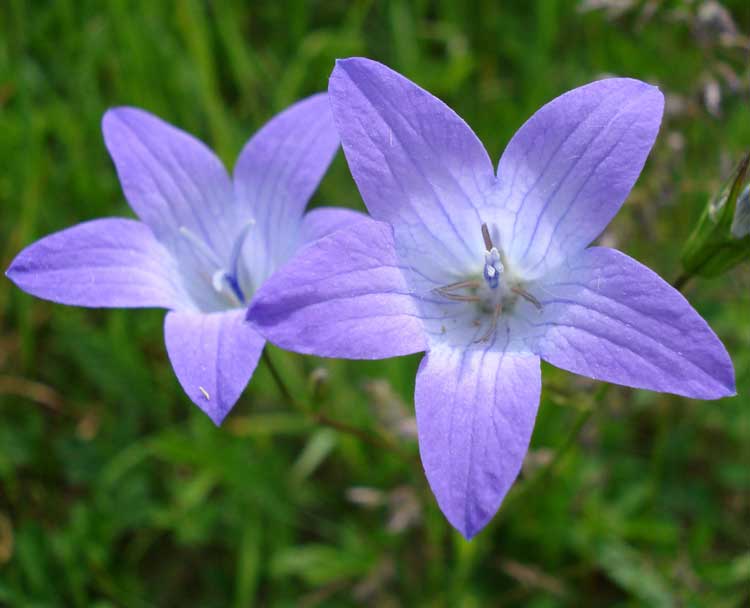
Campanula patula (*)
Classification System: APG IV
Superregnum: Eukaryota
Regnum: Plantae
Cladus: Angiosperms
Cladus: Eudicots
Cladus: Core eudicots
Cladus: Asterids
Cladus: Campanulids
Ordo: Asterales
Familia: Campanulaceae
Subfamilia: Campanuloideae
Genus: Campanula
Species: Campanula patula
Subspecies: C. p. subsp. abietina – C. p. subsp. alekovyi – C. p. subsp. costae – C. p. subsp. epigaea – C. p. subsp. jahorinae – C. p. subsp. patula
Name
Campanula patula L. (1753)
Synonyms
Homotypic
Rapunculus patulus (L.) Fourr., Ann. Soc. Linn. Lyon, n.s., 17: 111 (1869).
Neocodon patulus (L.) Kolak. & Serdyuk., Zametki Sist. Geogr. Rast. 40: 29 (1984)
Distribution
Native distribution areas:
Continental: Eurasia
Albania; Austria; Baltic States; Belarus; Belgium; Bulgaria; Buryatiya; Central European Rus; Connecticut; Czechoslovakia; Denmark; East European Russia; Finland; France; Germany; Great Britain; Greece; Hungary; Italy; Krym; Netherlands; New Hampshire; New York; North European Russia; Northwest European Russia; Norway; Poland; Romania; Sardegna; South European Russia; Spain; Sweden; Switzerland; Turkey-in-Europe; Ukraine; West Siberia; Yugoslavia
References: Brummitt, R.K. 2001. TDWG – World Geographical Scheme for Recording Plant Distributions, 2nd Edition
References
Linnaeus, C. 1753. Species Plantarum. Tomus I: 163. Reference page.
USDA, ARS, National Genetic Resources Program. Germplasm Resources Information Network - (GRIN) [Online Database]. [1]
Links
Govaerts, R. et al. 2019. Campanula patula in World Checklist of Selected Plant Families. The Board of Trustees of the Royal Botanic Gardens, Kew. Published on the internet. Accessed: 2019 Jul. 22. Reference page.
Hassler, M. 2019. Campanula patula. World Plants: Synonymic Checklists of the Vascular Plants of the World In: Roskovh, Y., Abucay, L., Orrell, T., Nicolson, D., Bailly, N., Kirk, P., Bourgoin, T., DeWalt, R.E., Decock, W., De Wever, A., Nieukerken, E. van, Zarucchi, J. & Penev, L., eds. 2019. Species 2000 & ITIS Catalogue of Life. Published on the internet. Accessed: 2019 Jul. 22. Reference page.
International Plant Names Index. 2019. Campanula patula. Published online. Accessed: Jul 22 2019.
The Plant List 2013. Campanula patula in The Plant List Version 1.1. Published on the internet. Accessed: 2019 Jul 22.
Tropicos.org 2019. Campanula patula. Missouri Botanical Garden. Published on the internet. Accessed: 2019 Jul 22.
Vernacular names
corsu: Campanella, Campanedda
čeština: zvonek rozkladitý
Cymraeg: Clychlys ymledol
Deutsch: Wiesen-Glockenblume, Wiesenglockenblume
English: spreading bellflower
español: campanillas, campanillas silvestres
eesti: Harilik kellukas
suomi: Harakankello
français: Campanule étalée, Campanule etalee
hornjoserbsce: Łučne zwónčki
magyar: Terebélyes harangvirág
lietuvių: Pievinis katilėlis
Nederlands: Weideklokje
polski: Dzwonek rozpierzchły
русский: Колокольчик раскидистый
slovenčina: zvonček konáristý
svenska: Ängsklocka
українська: Дзвоники розлогі ялицеві
Campanula patula or spreading bellflower is a plant species of the genus Campanula. It can grow to more than half a meter high.[1] This delicate bellflower bears lateral branches of pale blue or white flowers that are upright and funnel shaped. The leaves are narrow and pointed. Branches are often supported by the surrounding vegetation, so the plants can appear prostrate. The main difference between this and other bellflowers is that the petals in the bell are spread out and more pointed and this gives this species its common name.
Description
Spreading bellflower is a biennial herbaceous plant growing to a height of 25 to 80 centimetres (9.8 to 31.5 in). The stem is branched, erect and wiry and often reddish near the base. In its first year, this plant produces a rosette of short-stalked, slender, spatulate leaves. In the second year it sends up one or more flowering stalks. The leaves on these are alternate, linear and unstalked, the margins having rounded teeth. The inflorescence is a few-flowered terminal raceme. The calyx is fused and has five triangular lobes, sharp tipped and spreading. The corolla is five-lobed, 20 to 25 mm (0.8 to 1.0 in) long with five violet-blue (or occasionally white) fused petals. The corolla lobes are longer than they are wide. There are five stamens and a pistil formed from three fused carpels. The fruit is a strongly-veined, conical capsule. The flowering period is from June to September.[2]
Distribution and habitat
Single flower
Spreading bellflower is native to temperate parts of Europe and widely naturalised elsewhere. Its natural habitat is meadows, banks, open woodland, clearings, roadside verges, fallow fields and waste ground. In the United Kingdom it is rare in the wild, occurring mainly on infertile banks and rock outcrops. It needs light for the seeds to germinate so may reappear after many years of absence when the soil is disturbed.[2][3]
A bellflower weevil in the genus Miarus is associated with this plant.
References
Anderberg, Arne; Anderberg, Anna-Lena. "Campanula patula". Den virtuella floran (in Swedish). Swedish Museum of Natural History. Retrieved 27 November 2010.
"Spreading Bellflower: Campanula patula". NatureGate. Retrieved 2013-12-31.
"Campanula patula (Spreading Bellflower)". Online Atlas of the British and Irish Flora. Retrieved 2013-12-31.
Retrieved from "http://en.wikipedia.org/"
All text is available under the terms of the GNU Free Documentation License

